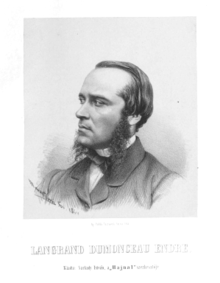André Langrand-Dumonceau

André Langrand-Dumonceau (1826–1900) was a Belgian financier, banker and entrepreneur and a major figure in European financial world of the 1860s.[1]
He was born in 1826 in the Belgian village of Vossem. He started his career in financial services, helped by his elder brother, who worked for a Belgian branch of a French insurance company. By the age of 36 he was in control of eleven companies across Europe.[2]
He was involved in an attempt to build a "Catholic financial empire", a counterweight to the perceived Jewish dominance of the financial sector.[1][3][4] He received international recognition, including a title of count at the Papal court, and "an international reputation as a financial genius".[5] His fortune collapsed in the late 1860s, triggering a major financial-political scandal in Belgium.[6]
During the period from the 1850s to 1870 he was involved with managing over twenty companies, including banks, and insurance and railway companies, a number of which he had founded;[3] including Royale Belge.[6] He received backing from a number of notable figures, including Pope Pius IX, Emperor Franz Joseph of Austria, Napoleon III of France, and King Leopold of Belgium.[3]
His financial plan, however, was unsound, being built on using one company's equity capital to take up the loan capital of another.[4] By the late 1860s, the strain of fund transfers on his network became too much to bear.[3] In the financial Crash of 1870 he declared personal bankruptcy and fled into exile; he was accused of theft, bribery and criminal recklessness, and was condemned in absentia after a trial that ran from 1872 to 1879.[3] He died in Rome in 1900.[3]
References
- 1 2 Maarten Van Dijck; Jan De Maeyer; Jeffrey Tyssens; Jimmy Koppen (26 March 2013). The Economics of Providence: Management, Finances and Patrimony of Religious Orders and Congregations in Europe, 1773– C 1930. Leuven University Press. p. 179. ISBN 978-90-5867-915-4.
- ↑ Accademia ligure di scienze e lettere (2003). Atti della Accademia Ligure di Scienze e Lettere (in Italian). Accademia Ligure di Scienze e Lettere. p. 154.
- 1 2 3 4 5 6 Michael Saffle; Rossana Dalmonte (2003). Liszt and the Birth of Modern Europe: Music as a Mirror of Religious, Political, Cultural, and Aesthetic Transformations : Proceedings of the International Conference Held at the Villa Serbelloni, Bellagio (Como) 14–18 December 1998. Pendragon Press. p. 80. ISBN 978-1-57647-027-5.
- 1 2 Gerald Posner (3 February 2015). God's Bankers: A History of Money and Power at the Vatican. Simon & Schuster. p. 16. ISBN 978-1-4391-0986-1.
- ↑ Cameron, Rondo E. (1 January 1962). "Langrand-Dumonceau, promoteur d'une puissance financière catholique. Vol. I, Années obscures—Montée. By G[uillaume] Jacquemyns. (Publication of the Institut de Sociologie Solvay, Centre d'Histoire Economique et Sociale.) Brussels: Université Libre de Bruxelles, 1960. pp. 320. 260 F.B.". The Journal of Economic History (in French). 22 (01): 115–116. doi:10.1017/S0022050700102633. ISSN 1471-6372. JSTOR 2114285.
- 1 2 Els Witte; Jan Craeybeckx; Alain Meynen (2009). Political History of Belgium: From 1830 Onwards. Asp / Vubpress / Upa. p. 64. ISBN 978-90-5487-517-8.
External links
- Leesfragment: Het gevecht met Leviathan. Een verhaal over de politieke ordening in Europa, 1815–1965 (Dutch)